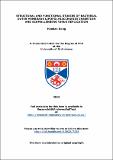Files in this item
Structural and functional studies of bacterial outer membrane lipopolysaccharide insertion and Schmallenberg virus replication
Item metadata
| dc.contributor.advisor | Naismith, Jim | |
| dc.contributor.author | Dong, Haohao | |
| dc.coverage.spatial | 180 | en_US |
| dc.date.accessioned | 2015-08-27T13:56:43Z | |
| dc.date.available | 2015-08-27T13:56:43Z | |
| dc.date.issued | 2015-08-03 | |
| dc.identifier | uk.bl.ethos.665189 | |
| dc.identifier.uri | https://hdl.handle.net/10023/7338 | |
| dc.description.abstract | Lipopolysaccharide (LPS) is an essential component of the outer membrane (OM) of Gram-negative bacteria and plays a fundamental role in protecting the bacteria from harsh environments and toxic compounds. The LPS transport system is responsible for transporting LPS from the periplasmic side of the inner membrane (IM) to the OM, in a process involving seven LptA-LptG proteins. The current model for lipopolysaccharide transport (Lpt) suggests that LPS is initially extracted by a four-protein complex, LptBCFG, from the inner membrane to the periplasm, where LptA mediates further transport to the OM. Another two protein complex, LptD/E, catalyses the assembly of LPS at the OM cell surface. However, the details of this transport mechanism have remained unknown, mainly due to a lack of structural information. In chapter 1 and 2 of this thesis, I report materials and methods for all LptD/E, and Schmallenberg virus (SBV) nucleoprotein (NP) experiments and the theories and software that were used in determining structures of LptD/E, SBV NP and the SBV NP/RNA complex. In chapter 3 of this thesis, I report the first crystal structure of the outer membrane protein LptD/E complex. LptD forms a 26-strand ß-barrel in a closed form and LptE is a roll-like structure located inside LptD to form “barrel and plug” architecture. Through structural analysis, function assay and molecular dynamics simulation, we proposed a mechanism in which the hydrophilic head of LPS molecule, including the oligosaccharide core and the O antigen, directly penetrates through the hydrophilic ß- barrel whilst the hydrophobic lipid A tail is inserted into an intramembrane hole, with a lateral opening between strand ß1 and ß26 of the LptD. LptE may assist this process. In chapter 4, I report the crystal structure of the SBV NP in two conformations: tetrameric when the protein was purified under native conditions, and trimeric when denatured and refolded during purification. The SBV NP has a novel fold and we have also identified that the N-terminal arm is crucial for RNA binding, and the N- and the C-terminal arm is essential for RNA multimerisation with adjacent protomers and for viral RNA encapsidation. Chapter 5 describes the crystal structure of SBV NP in complex with a 42 nucleotide long RNA (polyU). This ribonucleoprotein (RNP) complex was crystallized as a ring-like tetramer with each protomer bound to 11 ribonucleotides. Eight of these nucleotides are bound in a positively charged cleft between N- and C- terminal domains and three are bound in the N-terminal arm. I also compared the structure to that of other NPs from negative-sense RNA viruses, and found that SBV NP sequesters RNA using a different mechanism. Furthermore, the structure suggests that when RNA binds the protein, there are conformational changes in the RNA-binding cleft, and in the N- and C-terminal arms. Thus our results reveal a novel mechanism of RNA encapsidation by orthobunyaviruses NP. | en_US |
| dc.language.iso | en | en_US |
| dc.publisher | University of St Andrews | |
| dc.subject | Lipopolysaccharide | en_US |
| dc.subject | Bunyaviruses | en_US |
| dc.subject | LptD/E | en_US |
| dc.subject | Schmallenberg virus | en_US |
| dc.subject.lcc | QP632.E4D7 | |
| dc.subject.lcsh | Endotoxins | en_US |
| dc.subject.lcsh | Bunyaviruses | en_US |
| dc.title | Structural and functional studies of bacterial outer membrane lipopolysaccharide insertion and Schmallenberg virus replication | en_US |
| dc.type | Thesis | en_US |
| dc.type.qualificationlevel | Doctoral | en_US |
| dc.type.qualificationname | PhD Doctor of Philosophy | en_US |
| dc.publisher.institution | The University of St Andrews | en_US |
This item appears in the following Collection(s)
Items in the St Andrews Research Repository are protected by copyright, with all rights reserved, unless otherwise indicated.

